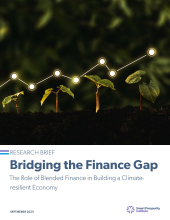September 2025
By Anik Islam
The climate challenge is becoming a financing challenge. Canada faces a $115 billion annual investment gap to transition to a low-carbon, climate-resilient economy. Closing this gap is critical to improve Canada’s competitiveness and decouple economic prosperity from environmental harm. However, governments cannot do it alone.
Climate policies and information tools help enable investment, but persistent market failures, which vary by sector and stage of project or company development, deter private investments. Investors also face their own challenges when investing in clean technologies or energy-transition projects, particularly those that are first-of-a-kind technologies and therefore lack a track record on returns.
To address this challenge, the Smart Prosperity Institute’s latest research brief, Bridging the Finance Gap: The Role of Blended Finance in Building a Climate-resilient Economy, explores the case for blended finance. Blended finance is a structuring approach that uses risk-tolerant, catalytic capital from public and philanthropic sources to attract capital from private sources seeking market returns on investment.
The brief provides an overview of blended finance and commonly used blended-finance instruments and structures, outlines project and investor-related challenges, and shows what blended finance can do to address them.
Key messages
- There are several market failures, from newness and complexities of technologies to a mismatch of policy and private-sector goals that deter private investments in the low-carbon economy. Barriers to private investment in the low-carbon economy are significant. They play out differently across project stages and sectors and are compounded by the higher upfront costs of many climate-friendly technologies compared to fossil-fuel alternatives. Different types of investors, such as banks, venture capital investors and pension funds also face challenges that limit investments.
- Blended finance uses a range of catalytic financing instruments and policy tools to create financing structures that unlock private capital for climate-aligned projects and entities. Instruments and policy tools include risk guarantees, subordinated debt and contracts for differences. Through these structures, private capital can achieve its desired risk-adjusted returns on investment, while the public and philanthropic sectors can achieve their environmental and socioeconomic objectives.
- While there are different types of blending, Canadian public financial institutions have expertise in high-risk investments where there is a limited track record on returns. The Canada Infrastructure Bank and Canada Growth Fund are prime examples of these institutions. They share information with different stakeholders, bundle funding and financing instruments, then collaborate with stakeholders to improve risk-return dynamics, bridge market gaps and build capacity.
- Blended finance is not a panacea for the climate-investment gap. Blended finance does not replace the need for macroeconomic and sector-specific reforms, such as maintaining carbon pricing signals and streamlining permitting processes. Careful design and governance of these financing structures are critical to ensure they deliver financing outcomes efficiently. Targeted research can clarify where blended finance can add the most value and how to design it effectively to support Canada’s climate and economic goals.
This brief is part of the Smart Prosperity Institute’s ongoing research agenda on blended finance. Upcoming work intends to take a closer look at the evolving role of blended finance in the clean innovation and energy transition agenda, including how institutions and climate policy frameworks are adapting to strengthen financing and achieve environmental and economic competitiveness outcomes for Canada.



